Weird And Wonderful; A Visit To The PMA Novelty Shop
Rubber chickens . Chocolate visiting cards. A camera support that looks (and performs) like a big, sticky limpet. Every bit as much as cameras, films, and imaging software, this weird and wonderful stuff is what the Photo Marketing Association show is about.
 |
|
|
We are talking, after all, about marketing. It is literally their middle name. Technically superior pictures--sharper, with better colors, more accurately focused--are only one tool for selling your hardware or your services to Joe Public. Others are speed, ease of use, low prices, and, let's not forget, sheer novelty. Hence the chocolate visiting cards and (from the same company) printing your customers' portraits on chocolate lollipops: archival permanence is presumably not an issue. These (along with birthday greetings, bar and bat mitzvah goodies, chocolate CDs, and more) come from Chocolate ImageMakers, inventors of Chocolography. Their slightly worrying slogan is, "If you can imagine it, we can create it."
 |
|
|
This is not to decry novelty, and indeed, even the rubber chicken is a valid photographic tool. Squeeze it; release the pressure; and it squawks. It would be a hard-hearted cynic or perhaps a merely miserable baby who did not laugh at this. If you are selling studio props to the baby photographer, including perhaps the best baby posing seat ever made, rubber chickens can be an extremely good idea. Unfortunately the company in question (American Photographic Resources) didn't take on-board my increasingly pointed hints, and give me one. At $12, maybe I should just have bought one. But (fortunately) I very seldom photograph babies, and a squawking rubber chicken is hard to justify otherwise, even as a conversation piece or delayed-action whoopee cushion. Besides, they had all sold out by Tuesday (the show ran from Sunday to Wednesday).
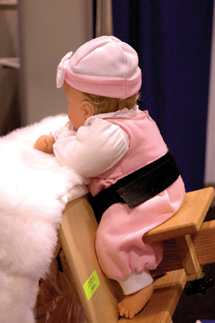 |
|
|
Rather more mainstream, and a lot more justifiable for what I do, was a tiny, compact tabletop tripod with a built-in (but detachable) LED flashlight from OSN. Only preproduction prototypes were at the show, and there were a couple of improvements to be incorporated in the final version: a better lock on the battery compartment, for example. But the prototype looks enough like the final version that I wanted to illustrate it here. It deserves a place in the bag or pocket of any photographer who has ever struggled in poor light to see his camera settings or find an elusive accessory. From the same company comes a bottle-top tripod adapter that doubles as a clamp for car windows and even (heavy) books--their suggestion, not mine. The gorillapod, also covered by Frances Schultz, is another brilliant, low-cost accessory.
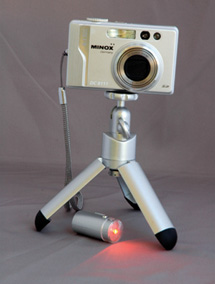 |
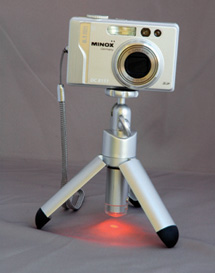 |
|
|
||
 |
|
|
|
 |
|
|
 |
|
|
A vastly more expensive piece of Weird Stuff ($7695-$16,995), but one I would buy if I could afford it, is the laser burning/engraving system from VersaLaser. Even if it couldn't do anything else, I'd buy it just to print on polished black marble. There is a gorgeous tonality to these pictures that rivals a top-flight silver-halide print, and of course, archival permanence is defined principally in terms of geological weathering. If it weren't for the fact that the fine art community might turn their noses up at pictures on stone, and dismiss them as a novelty, I might actually be tempted to try to find the money for one of these and make a name for myself as the only fine art photographer working in that medium. With a maximum burn area of 16x20" (40x50cm), these systems also do brilliant pictures on wood, ceramics, glass, and many other materials. The more expensive (and therefore more powerful) models can also burn metals, including stainless steel.
 |
|
|
In fact, this set me to thinking about how, in some ways, we are going back
to the 19th century in photography. In Abe Lincoln's day--and indeed,
in Teddy Roosevelt's--Having Your Likeness Took was something of
a ceremony, a ritual, and the pictures were rare treasures. Professionals used
huge, expensive plate cameras; amateurs, at least after 1888, tended to press
the button on a very basic camera and let Kodak do the rest. For most of the
20th century the gap narrowed steadily: pros and serious amateurs alike used
Leicas, Hasselblads, Nikons, Linhofs. By the 1980s the gap had all but vanished:
more and more "amateur" cameras could deliver exactly the same quality
as "pro" models. But today, if you want anything approaching film
quality, you'd better buy at least 14 megapixels and preferably 20+. Only
a very few rich amateurs do this: the vast majority are content with 8 megapixels
or less.
As for pictures as rare treasures, until the digital revolution, we got prints
(or transparencies, or at least negatives) whether we liked it or not. If we
were resolute enough we would throw out the bad ones, but the vast majority
would be stored somewhere. Maybe an album, maybe a shoe box, maybe the back
of a drawer, but they wouldn't go away. Today, according to whom you believe,
anything from 90-99 percent of the digital images that are captured will never
have a physical existence as prints. Many are deleted; some are "shared"
and lost in cyberspace; and by far the greater part even of the ones that are
"archived" will sooner or later be lost. At the show, Delkin Devices
introduced CDs with a 300-year life. But how will anyone read them in 300 years'
time? And why should they bother? You can't hold a CD up to the window,
as you can a negative, and be fascinated by the life of 50 or 100 or 150 years
ago: you have to work quite hard to read it, with the appropriate machine.
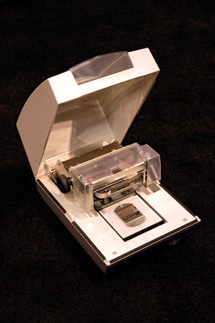 |
|
|
Life doesn't work that way. How often, after all, have you been on the point of throwing something away, then stayed your hand because of the memories it brought back? Expecting our descendants to act otherwise is like asking today's journalists to go back to the quill pen; or accountants to the leather-bound ledger; or physicians to leeches; or cooks to the open fire. No wonder a favorite theme was "Imagine your pictures" or "Limited only by your imagination," because in a few decades' time, memory and imagination may be all that we have, because there won't be many real pictures.
 |
|
|
Yet these strange and occasionally tacky novelties--pictures burned on marble, or printed on stainless steel with a sort of super dot matrix printer (Roland), or created by aiming two lasers so they intersect in a block of glass (inSpeck and Crystal Impressions), or woven into a blanket or tapestry (Portrait Weavers and others)--will however survive for their very uniqueness, quite apart from their inherent durability and value. Even if you don't know who these people are, you can still look at them and be intrigued, as we look at a tintype today. If you do know, it is all the more marvelous.
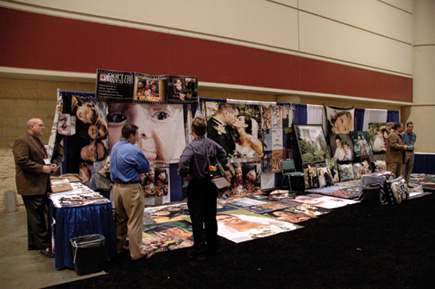 |
|
|
In fact, it's a strange thought that in 2075 the only picture of great-grandpa Chuck as a boy may be on the side of a badly scuffed football --as the man on the BallStars stand cheerfully confessed, "We don't know how long they last, but it seems to be a pretty long time, because we haven't seen any fading in 10 years"--or burned into the wood of a fruit bowl or picture frame that may have become chipped and stained over the decades (VersaLaser again, or on a jigsaw puzzle (Brooke International ), or perhaps on a tiled mural where he was a page-boy at his uncle's wedding (Photo USA Corp. among others).
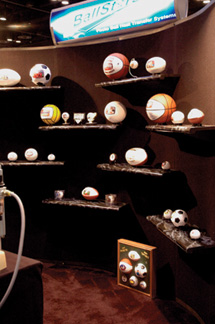 |
|
|
The other thing that really struck me about PMA 2006 is a truth I have known for a long time: that the vast majority of photographers are mean and short-sighted. They have an undying love affair with new cameras, but are stingy beyond belief when it comes to laying out money for real quality. Or even for modestly-priced products that would do a great deal more for their photography than updating last year's rather ordinary camera with this year's equally ordinary camera.
 |
|
|
|
 |
|
|
Perhaps the most everyday example of quality is batteries. Both Energizer and Varta made this point. Their top-quality lithium AA cells give far and away the most bang for the buck, as compared with alkaline or (worse still, though they are hard to find today) zinc-carbon cells. Yes, they cost several times as much. But they last so much longer, and give out so much more power, that the cost per operating hour (or flash, or digital image, or whatever) is a fraction of the comparable cost for the cheapest batteries, and a good deal less than even the more conventional batteries in their own alkaline line-ups. And today's Ni-MH rechargeables are incredible, too: up to 2.7 Amp-hours (there's no sense in quoting milliAmp-hours anymore) from a single AA.
 |
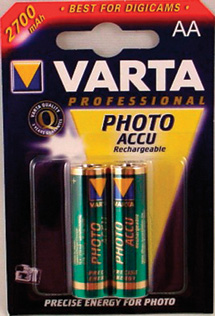 |
|
|
||
For a rather more expensive example, a top of the line EIZO monitor is around $5700. This is 10 or 20 times the price of the cheapest half-decent color monitors you can buy, and maybe 100 times the price of the out-and-out cheapest; but if you want the maximum quality available, that's what it costs. I couldn't begin to justify that, but the least expensive EIZOs are only a bit over $1000, and I'm tempted.
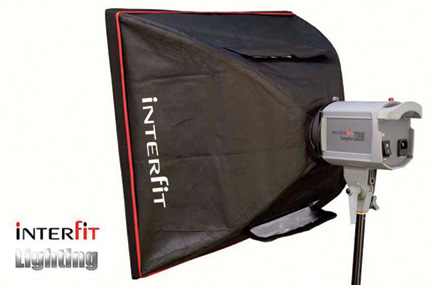 |
|
|
What about the modestly-priced products that make for better pictures? Well, I've already mentioned the rubber chicken (and I'm not kidding) but how about a mock marble (glass-fiber) posing pillar? You know: the sort of mock-Corinthian thing that our Victorian forebears would rest an arm upon while looking Serious, Diligent, Important, or Learned? They're still available. And they're not expensive: they start at well under $100. For props, and indeed entire sets, take a look at companies such as Rotonics, Off The Wall, and others. Or lights: Paterson does a tremendous range of flash, hot (tungsten) lights and cold (fluorescent) lights, with new models and improvements almost monthly, while Lowel's Ego folding light is a piece of genius. Or a depth of field calculator from ExpoImaging. For $20 or so, you can dial in the focal length of your zoom and either work from the aperture (f/8 will give me...) or from the depth of field you want (if I want this, I'd better use f/11...). Then there are silly, cheap underwater cameras from Snap Sights!, both silver halide ($10-$20) and digital ($100-$120), complete with underwater housing.
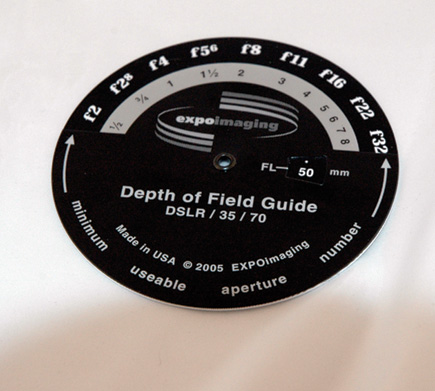 |
|
|
|
 |
|
|
|
 |
|
|
And this, inexorably, leads us back to Weird and Wonderful Stuff. Camera supports
are always interesting, especially the Giant Sticky Limpet. Actually, they call
it the MonsterPod, but Giant Sticky Limpet is an even better name. It's
one of life's weirder camera supports, but as Frances Schultz is covering
it under tripods, I'll content myself with merely mentioning it. The same
for the gorillapod: a very clever, very innovative product.

































